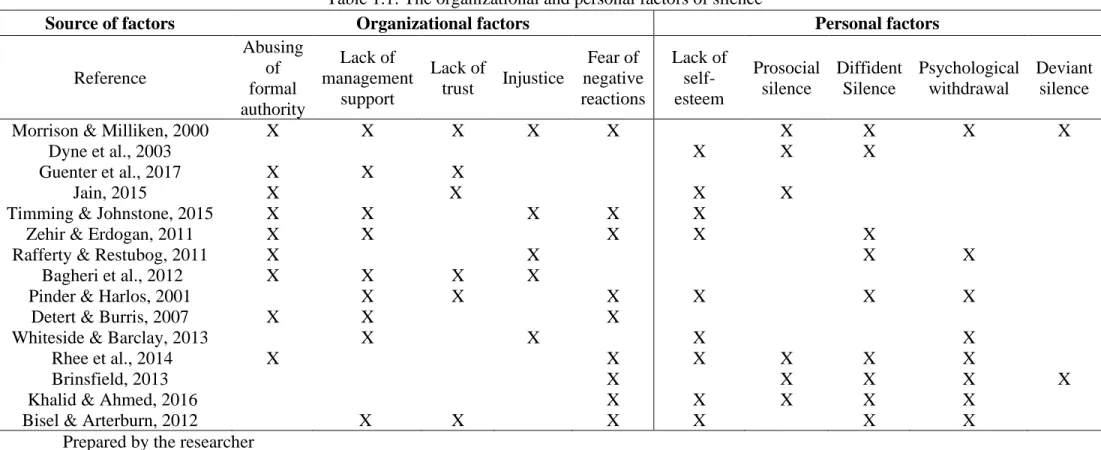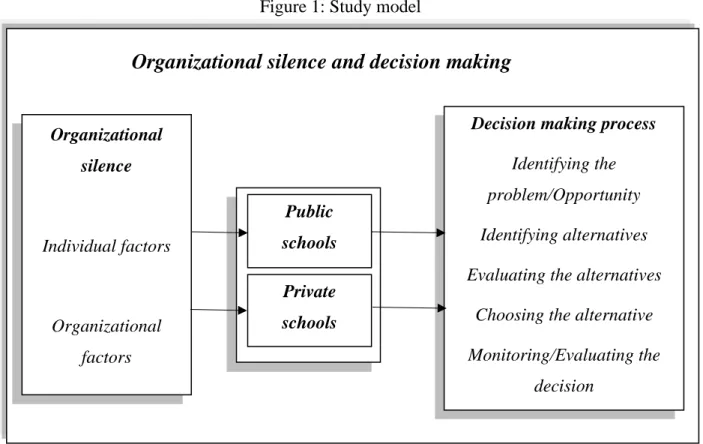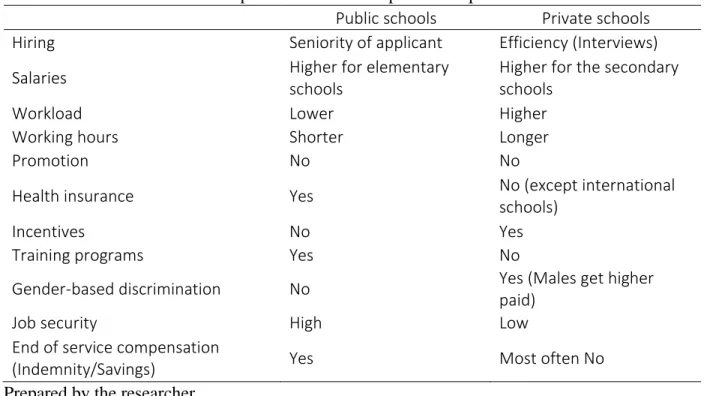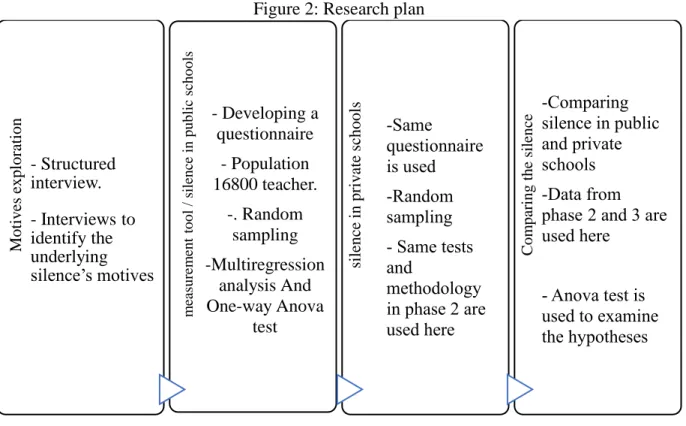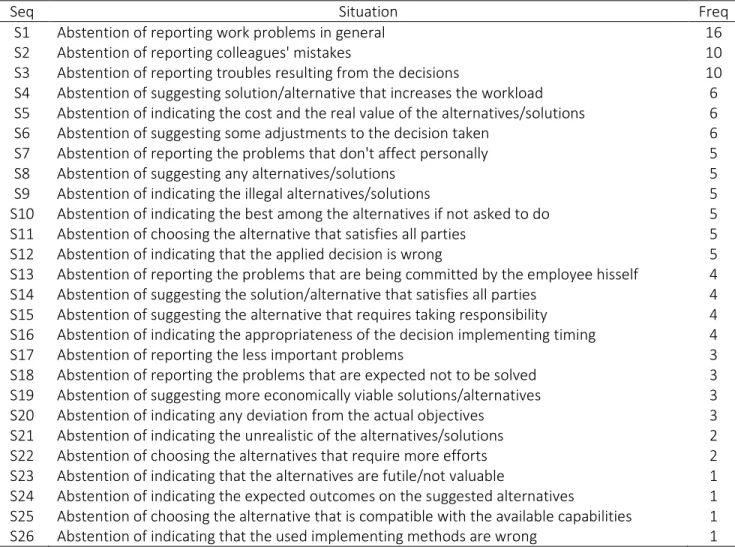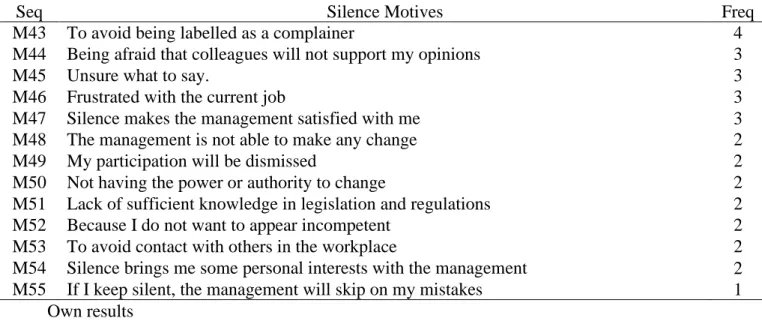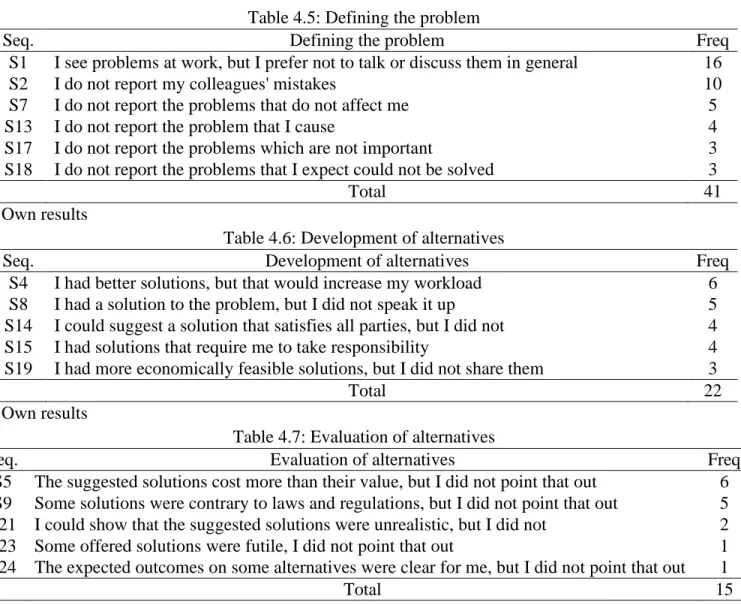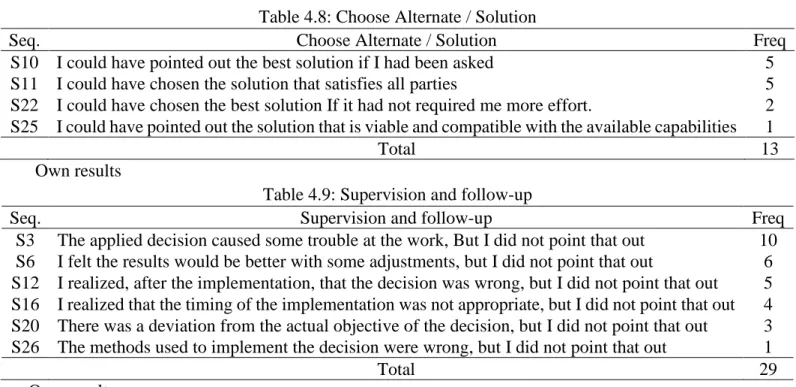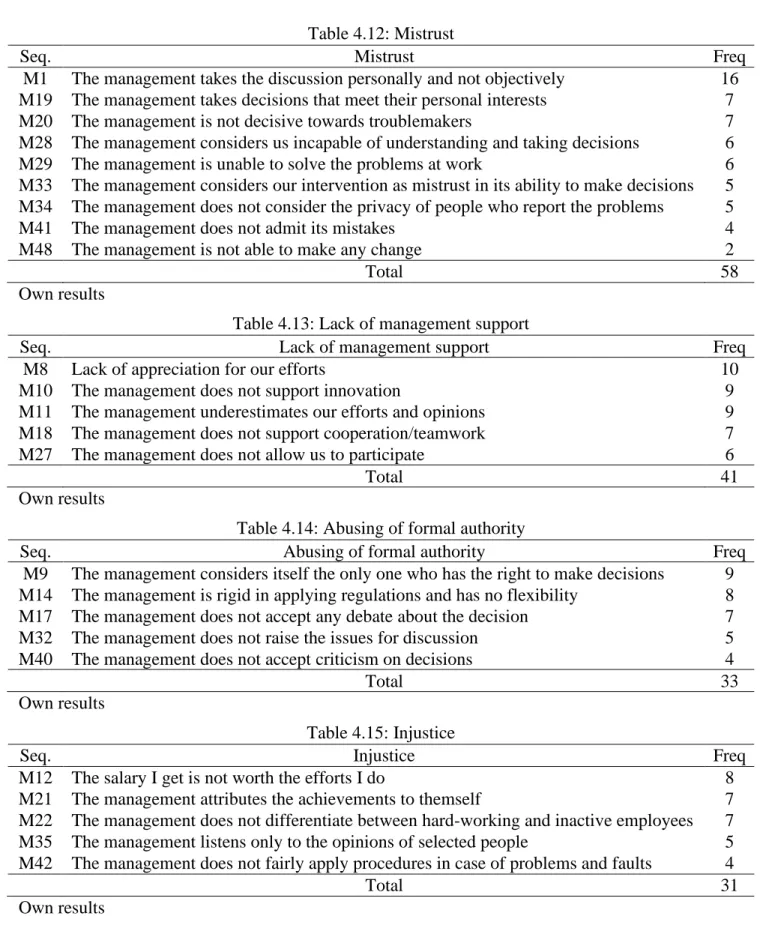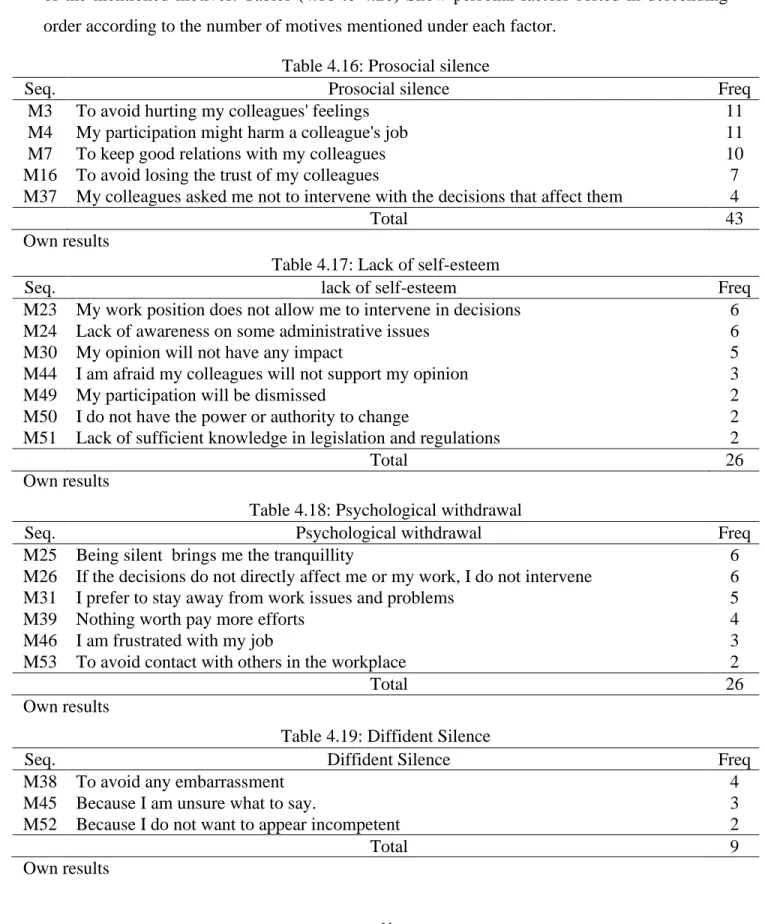-i-
DOCTORAL (PhD) DISSERTATION
Osama Khaled Ahmad Alkhlaifat
University of Sopron Sopron
2021
-ii-
UNIVERSITY OF SOPRON FACULTY OF ECONOMICS
The István Széchenyi Doctoral School of Economics and Management Employees' silence towards the decision-making process
Case Study: Public and Private Schools in the Kingdom of Jordan
PhD. DISSERTATION
By: Osama Alkhlaifat
Supervisor:
Dr. Koloszár László
Sopron
2021
-iii-
The decision of the committee
Employees' silence towards the decision-making process
Dissertation to obtain a PhD degree Written by: Osama Khaled Ahmad Alkhlaifat
Prepared by the University of Sopron ______________________ Doctoral School
within the framework of the _________________ Programme Supervisors: Dr Koloszár László
The supervisor(s) has recommended the evaluation of the dissertation be accepted: yes / no ____________________
_____________supervisor signature
Date of comprehensive exam: 20_____ year ___________________ month ______ day Comprehensive exam result __________ %
The evaluation has been recommended for approval by the reviewers (yes/no)
1. judge: Dr. ____________________________ yes/no _____________________ (signature) 2. judge: Dr. ____________________________yes/no _____________________ (signature) Result of the public dissertation defence: ____________ %
Sopron, 20____ year __________________ month _____ day
_____________________
Chairperson of the Judging Committee Qualification of the PhD degree: _______________________
_____________________
UDHC Chairperson
-iv-
Contents
Decision of the committee ... iii
Contents ... iiv
Table & Figur & Appendices ... vi
Abstract ... 1
1 Introduction ... 3
1.1 The problem of the study ... 5
1.2 Overall value-added ... 6
1.3 The hypotheses ... 7
1.4 The focus of this dissertation ... 8
2 Literature ... 10
2.1 Classical and Neo-classical theory ... 10
2.2 Silence/voice behaviour and important managerial terms ... 12
2.3 Factors exploration-focused previous studies ... 20
2.4 Organizational/contextual factors ... 27
2.4.1 Formal authority abuse ... 27
2.4.2 Lack of support ... 27
2.4.3 Mistrust ... 28
2.4.4 Injustice ... 28
2.4.5 Fear of negative reactions ... 29
2.5 Personal factors ... 30
2.5.1 Lack of Self-esteem ... 30
2.5.2 The prosocial factor ... 30
2.5.3 Diffident factor ... 30
2.5.4 Psychological withdrawal ... 31
2.5.5 Deviant factor ... 31
2.6 Organizational silence and the Decision-Making Process ... 32
2.6.1 Problem identification and data collection ... 33
2.6.2 Development and evaluation of alternatives ... 34
2.6.3 Choosing the best solution/alternative ... 35
2.6.4 Follow up on the implementation ... 36
2.6.5 The public and private sector in Jordan ... 38
3 Methodology ... 42
3.1 Terminology ... 42
3.2 Phase 1 methodology ... 42
3.2.1 Study sample ... 42
3.2.2 Interviews ... 43
3.3 Phase 2 methodology ... 43
3.3.1 Study Population and Sample: ... 43
3.3.2 Study Tool: ... 43
3.3.3 Relative importance, Reliability of the tool, Multicollinearity and Regression analysis ... 44
3.4 Phase 3 methodology ... 46
3.4.1 Study Population and Sample: ... 46
-v-
3.5 Phase 4 methodology ... 46
4 Empirical studies on silence problem in public and private schools ... 48
4.1 Phase 1: Exploration of silence's motives towards the work decisions and building a measurement tool. ... 49
4.1.1 Study plan and methodology ... 49
4.1.2 Data collecting ... 49
4.1.3 Interpreting responses and deriving causes and situations: ... 51
4.1.4 Results ... 54
4.1.5 Building the measurement tool ... 62
4.1.6 Discussion of results: ... 65
4.2 Phase 2: Measuring silence and its impact on the decision-making process in public schools ... 68
4.2.1 Jordanian Public Schools: ... 68
4.2.2 Research Methodology: ... 69
4.2.3 Study Population and Sample: ... 69
4.2.4 Study Tool ... 69
4.2.5 Data analysis and hypotheses testing... 70
4.2.6 Discussion ... 77
4.3 Phase 3: Measuring silence and its impact on the decision-making process in private schools ... 80
4.3.1 Private schools ... 80
4.3.2 Study tool, Sampling and methodology ... 81
4.3.3 Data analysis and hypothesis testing ... 81
4.3.4 Discussion ... 87
4.4 Phase 4: A comparison of the organizational silence in public and private schools ... 92
4.4.1 Data analysis and hypotheses testing... 93
4.4.2 Discussion ... 95
5 Conclusion and limitation ... 999
5.1 New scientific results ... 99
5.2 Conclusion and Application ... 101
5.3 Limitation and future work ... 102
Summary………..104
References ... 105
Appendices ... 121
Acknowledgement ... 138
Declaration... 139
-vi-
Table & Figur & Appendices
Table 1.1: The organizational and personal factors of silence ... 26
Figure 1: Study model ... 32
Table 1.2: A comparison between the public and private schools ... 41
Table 3.1: Key Interpretations of the Results of Relative Importance Index (RII) ... 44
Figure 2: Research plan ... 47
Table 4.1: Decision-related situations reported by the respondents ... 52
Table 4.2: Motives reported by the respondents ... 53
Table 4.3: The tendency towards the silence ... 54
Table 4.4: Reliability Statistics ... 55
Table 4.5: Defining the problem ... 55
Table 4.6: Development of alternatives ... 55
Table 4.7: Evaluation of alternatives ... 55
Table 4.8: Choose Alternate / Solution ... 56
Table 4.9: Supervision and follow-up ... 56
Table 4.10: Reliability Statistics ... 59
Table 4.11: Fear of negative reactions ... 59
Table 4.12: Mistrust ... 60
Table 4.13: Lack of management support ... 60
Table 4.14: Abusing of formal authority ... 60
Table 4.15: Injustice ... 60
Table 4.16: Prosocial silence ... 61
Table 4.17: Lack of self-esteem ... 61
Table 4.18: Psychological withdrawal ... 61
Table 4.19: Diffident Silence ... 61
Table 4.20: Deviant silence ... 62
Table 4.21: The frequency of silence's motives within each factor ... 62
Table 4.22: Reliability test ... 63
Table 4.23: Demographic distribution. ... 69
Table 4.24: Cronbach's Alpha test... 70
Table 4.25: The VIF and tolerance values for the independent variable ... 71
Table 4.26: The mean and S. d. ... 72
Table 4.28: Multiple regression for the second main hypothesis ... 74
Table 4.29: ANOVA-Gender ... 75
Table 4.31: ANOVA-experience ... 76
Table 4.32: ANOVA- Education Level ... 76
Table 4.33: Demographic distribution ... 81
Table 4.34: The mean and standard deviation ... 82
Table 4.36: Multiple regression for the fifth main hypothesis ... 84
Table 4.37: ANOVA-Gender ... 85
Table 4.38: ANOVA-Age ... 85
Table 4.39: ANOVA-Experience ... 86
Table 4.40: ANOVA-Education level ... 86
Table 4.42: Test of the differences in personal factors in both sectors ... 93
Table 4.43: Test of the differences in organizational factors in both sectors ... 94
Table 4.44: Test of the differences in silence in both sectors ... 95
Table 5.1: Summary of hypothesis tests ... 100
Appendix 2A: coding the silence factors ... 122
-vii-
Appendix 2B: coding the stages of the decisions factors ... 122
Appendix 3A: Classification results of the decisions-related situations ... 123
Appendix 3B: Classification results of the decisions-related situations ... 124
Standard deviation and relative importance (Decision-making items) ... 126
Appendix 5: Standard deviation and relative importance (silence items) ... 128
Appendix 6: Study tool ... 132
Appendix 7: Test of Homogeneity of Variances- public schools... 137
Appendix 8:Test of Homogeneity of Variances- private schools ... 138
-1-
Abstract
Employees' silence towards the decision-making process
Case Study: Public and Private Schools in the Kingdom of Jordan
The deliberate withholding of information and feedback by employees has been linked to various individual and contextual (organizational) factors. Recently, the problem of employees silence has been studied separately and become an important issue in the organizational sciences beyond the absence of employees voice. Despite the huge interest in the silence problem, no studies directed to investigate the underlying motives of the silence phenomenon towards the decision-making process (DMP). All studies searched the silence factors at the workplace in general. Thus, this study applied in the Jordan ministry of education (MOE) attempts to enhance our understanding of this phenomenon by linking it with one of the most important managerial functions, the decision-making process. A silence model is suggested; it shows the main factors under which the discovered motives to be classified. Following three studies are designed and carried out to (a) investigate the motives for silence towards the decision-making process from the teachers' point of view, (b) develop a measurement tool of silence based on these motives and testing the hypotheses in the public schools, (c) Testing the tool and the hypotheses in the private schools as part of the private sector. The exploration phase utilized structured interviews with open-ended questions directed to reveal the underlying silence motives and decision- related situations where employees chose silence; 100 interviews were conducted in both types of schools. Five HR specialist has classified the founded motives according to the factors to which each belongs. The second phase utilized a questionnaire tool that has been built based on the first phase results. The data collected from public schools, and the sample was 1643. Multi regression analysis and ANOVA test were used to analyze the data. The third phase is measuring and testing hypotheses in private schools. The sample was 1208, and the same methodology and analysis methods used in phase 2 were used here.
Among the most important results, a new measurement tool directed at silence problem towards the decision-making process has been developed. In addition, the motives identified in this study are more specified and directly correlated to the decision-making process, which could help
-2-
enhance the employees' participation. The results also indicate that silence towards participation in the decision-making process can be measured. However, the silence problem exists at a medium level in both types of schools and inversely related to participation in the decision- making process. Research confirmed that organizational factors have more impact on the participation in the DMP in both public and private schools than personal factors (H1-2-4-5-7- 8). It also confirmed that there are no differences in responses regarding the respondents' gender and education level, but there is a significant difference regarding their age and experiences in both public and private schools (H3 and H6). Finally, the research confirmed that there are statistically significant differences among the silence factors and in silence degree based on the sector variable (H9 and H10).
Based on the results of this research, the MOE has to pay more attention to this problem since it affects not only the DMP but also the organizational performance in many areas. The public sector, in general, has to revise the recruitment methods; conducting exams and in-person interviews are important and could help in avoiding many unwanted personal characteristics.
Moreover, a plan is needed to treat the current situations in the schools' environment regarding the silence problem. Such a plan could be redesigning the training programs to enhance both the employees' personality and management quality.
Finally, one of the important studies to be suggested is conducting in-depth qualitative interviews with Jordanian schools' principals. This helps in reaching more motives and details on the employees' silence from a different point of view. Thus, more details and motives could be revealed on the silence problem from different perspectives.
-3-
1 Introduction
There are various considerations when comparing the public and private schools in Jordan. This research is focusing on two main components of the schools. The first is the contextual components; related to the schools' structures and regulations. The other component is the quality of employees' characteristics. The researcher highlights the most important points to be compared when talking about the two sectors. Hiring methods is considered one of the significant difference between the public and private sector in Jordan. In addition, the work conditions, the environment it which each type of schools works, salaries, incentives, training programs, level of job security and the compensation paid on the end of service. However, the schools do not produce testable physical products. It is hard to measure the quality of the outputs.
Thus, the quality of processes and human resources have to be given more importance.
Organizations have plenty and different forms of resources with different functions. However, human resources remain the most critical element in the organizations' success or failure at all administrative hierarchy levels. Human resources are the main sources to generate experience and knowledge (Moghaddampour et al., 2013). Indeed, the employees' role exceeds fulfilling assigned tasks to a broader administrative role (e.g., contributing to the decision-making process, solving work problems, providing views, suggestions, and information on the work- related issues). This contribution by employees could guarantee a sufficient amount of information and details available on the workflow, which improve the decision quality and overall organizational performance and effectiveness (Marusich et al., 2016).
Despite the importance of participation and sharing information, employees may prefer to remain silent and abstain from providing any information or provide it incompletely (Dimitris
& Vakola, 2007). This abstention could disrupt the organization's various administrative functions, especially those that require and rely heavily on the availability of the largest amount of information as in the decision-making process. Hence, the silence received great attention in the recent studies of organizational behaviours and problems.
Deliberate withholding of information, feedback, and opinions by employees have been linked to many critical individuals and organizational outcomes; (Nafei, 2016; Peirce et al., 1998;
Takhsha et al., 2020; Zehir & Erdogan, 2011). Although employees' voice behaviour has been
-4-
discussed from different perspectives; for example, issue selling to top management, organizational learning, change and development, knowledge exchange, citizenship behaviours within organizations, whistle-blowing (Argyris, 1993; Dutton & Ashford, 1993; Hollenbeck et al., 1996; Kowalski, 1996), these efforts have not considered the special nature and impact of intentional silence. According to previous voice investigations, silence supposes an absence of the information and feedback (positive and negative) associated with voice. Also, the factors which cause the employees to speak up will reduce silence. Thus, in this study, there is no need to investigate whether the silence is intentional or not. The reviews of employees' voice behaviour already consider silence as a natural byproduct.
However, the employees' silence has come to be considered an important area of investigation in its own right. Employee silence is defined in the literature as an intentional withholding of work-related information based on different underlying motives (Dyne et al., 2003; Pinder &
Harlos, 2001). The intentionality here is related to fulfilling an underlying motive that differentiates organizational silence from any other silence arising from not having anything to say or the pauses in everyday verbal discourse. Thus, the un-deliberated silence does not belong to organizational silence because it is not motive-driven.
Studying the phenomenon of employee silence towards the decision-making process as behaviour driven by specific motives and not as a normal absence of voice is important for several reasons. Bearing in mind that employees silence is intentional behaviour that comes from different motives — it is potentially much complex than that suggested by interpreting it as voice absence. Logically, there are motives behind employees silence which are different from absence motives for voice. Also, individual and organizational factors that cause silence and associated consequences are likely to differ as a function of the fundamental motives. Thus, silence and voice absence associated motives are not necessarily the same.
Although a pervasive phenomenon, some issues remain unsolved, such as (a) what does compose employees silence towards the decision-making process? (b) how can it be dimensionalized and measured? And (c) what factors give rise to these various motives of organizational silence? Therefore, the proposed research represents an important step in understanding this crucial issue. It investigates and examines the various motive-based factors of silence towards the decision-making process, develops a measuring tool, and explores the
-5-
size and impact of this problem. However, this research is conducted in the Jordanian schools' environment since the researcher has access to the needed sample, which could improve the study's reliability. In addition, the similarity of the goals and tasks in both types of schools allows us to compare the two sectors with the lowest impact of other factors.
Pinder & Harlos (2001) indicated that one of the main obstacles associated with studying the silence problem is deciding what forms the research boundaries and conditions. Thus, a clear definition and articulation of boundary conditions are essential for solid empirical research.
Therefore, our first phase in this dissertation is to clearly identify what constitutes silence towards the decision-making process within the public and private schools. It's a critical step if research is to proceed systematically.
A good understanding of the silence problem requires a more in-depth look. The researcher has studied silence as behaviour during the decision-making process. Moreover, although organizational silence has been considered a deliberated behaviour (Guenter et al., 2017;
Morrison & Milliken, 2000; Pinder & Harlos, 2001), discussing the behaviour effect without determining the hidden motive(s) is considered ambiguous. Researchers attempted to identify the different silence factors by presenting it as a reaction to various reasons (e.g. protecting social relationships, causing harm, self-defence, impress the management; Dyne et al., 2003;
Pinder & Harlos, 2001; Premeaux & Bedeian, 2003). Also, they searched in the role and effect of silence on different organizational aspects, including development and change, the role of leadership styles in silence, and the solutions to overcome the problem of silence (e.g., Morrison
& Milliken, 2000; Detert & Burris, 2007; Guenter et al., 2017; Huang et al., 2005). However, beyond these studies, which deal with general silence at the workplace, there is a need for more thorough exploration relative to the existence, measurement, and impact of the silence motives.
Therefore, this research is indeed vital; it empirically explores the underlying motives of organizational silence towards the decision-making process and their impact on it.
1.1 The problem of the study
This study aims at answering some questions, which in turn answer the main research question about the motives and factors of silence associated with the organizational decision-making process. These questions include
-6-
- Does the silence problem towards the decision-making process exist among teachers in the schools of Amman governorate?
- What is the strength and direction of the relationship between silence and participation in the decision-making process in public and private schools?
- What are the underlying motives and factors of the silence towards the participation in decision making according to teachers perspectives?
- Does silence have a significant impact on participation in the decision-making process?
- Is there any difference between the public and private schools regarding the silence level and the motives?
1.2 Overall value-added
The development of a specialized measurement tool of employees silence towards the decision- making process, along with the proposed qualitative and empirical studies, should contribute to a better understanding of this behaviour. The proposed model contributes to a better understanding of the motives and factors that lead the employees to keep silent and not participate in decisions. The investigation of motives and factors (phase 1), and following studies based on these motives (phase 2 & 3), will enable more empirical studies. Moreover, most often, the work tasks differ in both the public and private sectors. These differences and their companion factors, out of the study model, could affect the results when comparing the same issue in different sectors. For example, comparing the silence at police offices with silence at the private schools, or ever in public schools, could be affected by the nature of the tasks as will as the main silence factors. Therefore the researcher believes that the education field represents an excellent environment for studying and comparing work behaviour issues because of the highly close tasks nature. Phase 2 and 3 allow for exploring the silence problem under ideal research conditions. This belief has been formed due to the researcher's job nature as an employee at the HR department in the Jordan ministry of education. Finally, in addition to contributing to the theory relative to organizational silence, Phase 3 will also provide further validity evidence of the recently developed measurement tool's validity.
-7-
1.3 The hypotheses
Employees believe that the problem lies not only in their desire to remain silent, but in the factors driving them to do so, and their impact on the performance and loyalty to the organization (Morrison, 2011). Therefore, many studies searched deeply in the silence problem to determine the underlying motives and establish the relationship between silence and the different organizational concepts and behaviours such as leadership patterns, organizational loyalty, performance and many more.
Considering this study aims to measure the degree of silence problem and its impact on the decision-making process in public and private schools, the researcher assumes that all personal and organizational factors impact participation in the decision-making process. Moreover, the researcher supposes that there would be differences in responses based on respondent's gender, age, length of experience and level of education.
- H1: There is a statistically significant impact (at the level α ≤ 0.05) of Personal (individual) factors (Prosocial factor, Lack of self-esteem, Psychological withdrawal, Diffident Silence and Deviant silence) on the decision-making process in the public schools.
- H2: There is a statistically significant impact (at the level α ≤ 0.05) of organizational factors (Lack of trust, lack of management support, abusing formal authority, Injustice and Fear of negative reactions) on the decision-making process in the public schools.
- H3: There are significant differences in the respondents' responses based on the demographic variables (gender, age, experience and education level) .
- H4: There is a statistically significant impact (at the level α ≤ 0.05) of Personal (individual) factors (Prosocial factor, Lack of self-esteem, Psychological withdrawal, Diffident Silence and Deviant silence) on the decision-making process in the private schools.
- H5: There is a statistically significant impact (at the level α ≤ 0.05) of organizational factors (Lack of trust, lack of management support, abusing formal authority, Injustice and Fear of negative reactions) on the decision-making process in the private schools.
- H6: There are significant differences in the respondents' responses based on the demographic variables (gender, age, experience and education level) .
- H7: organizational factors are expected to have a greater impact on participation in decision- making than personal factors in public schools.
-8-
- H8: Personal factors are expected to have a greater impact on participation in decision-making than personal factors in public schools.
- H9: There are statistically significant differences between the silence factors based on the sector variable.
- H10: There is a statistically significant difference in the degree of silence between public and private sector schools.
1.4 The focus of this dissertation
Our study contributes to a better understanding of the silence phenomenon, where a general model of employee silence towards the decision-making process is presented. This model and its component and related factors are necessary for understanding what does constitute employee silence towards the decisions in processing. Three related studies are conducted with this study as follow.
The first study investigates the relative underlying motives of employee silence towards the decisions and develops a typology of employee silence motives based on underlying factors.
Previous researches developed different measures of general organizational silence behaviours (e.g., Brinsfield, 2013; Jain, 2015; Milliken et al., 2003; Vakola & Bouradas, 2005), but none have assessed silence towards a particular issue as we do here. However, this study repositions the lens closer to a specific issue to reach more accurate results in this field. Moreover, besides exploring the motives, the purpose is to develop reliable, specialized, and situationally measures of employee silence based on the investigated motives. This measurement tool does not apply only to the intentional silence towards decisions but supposed to help in other situations.
Phase 2 aims to develop valid measures of silence towards the decisions and carry out an empirical study within the public schools. Thus, the main aims are to (a) refine the items developed in the previous phase, (b) examine the factors and their underlying motives, and (c) make sure of the generalizability of the new measures. This study is designed to investigate the degree of silence and outcomes of specific factors based on phase 1 results. Based on our investigatory study and previous related researches (e.g., Dyne et al., 2003; Milliken et al., 2003;
Pinder & Harlos, 2001), it is expected that the silence to exist among the teacher and all identified factors to have an impact on participation in the decision-making process. It logically
-9-
makes sense that silence factors will vary as a function of the related motives. For example, silence based on the need for self-defence will differ from silence associated with the motive of diffident. Similarly, silence associated with the need to be prosocial is likely differing from this associated with mistrust. This is why there is a need to specify and examine the underlying motive of organizational silence towards a particular issue as in our case, and why the typology of motive-factors is valuable.
The last study comes from the researcher's belief that the nature of the sector could affect the silence problem and its underlying motives; therefore, this study is the same as the second one, but this time the questionnaire is already refined and tested. Thus, the primary goals here are (a) investigating the silence problem in private schools (private sector), where the previous study was in the public ones (public sector), and (b) make sure of the generalizability of the developed measurements.
-10-
2 Literature
Despite the multiplicity of the resources and the differences in their forms and functions, the human element remains the most important one. It has a critical role in the organizations' success and failure, regardless of their hierarchy position. The management scientists have considered the human component the most vital source to generate experience and knowledge (Moghaddampour et al., 2013). Nowadays, the staff's role is no longer limited to fulfilling the tasks and duties assigned. They have an essential role in the administrative process and activities (Detert & Burris, 2007). This role could include contributing to the decision-making, contributing to problems solving, work development by making suggestions and sharing their views. The different forms of contributions guarantee a sufficient amount of details and information available on the workflow. Thus, the quality of decisions is to be improved, which increases overall performance and effectiveness (Marusich et al., 2016). This section focuses on how silence factors and the decision-making process have been studied in general and how these factors impact the DMP.
The silence academics sheds light on how this behaviour might emerge and persist in the face of public opinion conformity. Individuals typically choose silence in contexts of inadequate public support, as a result of fear of solitude or self-doubt, according to Noelle-Neumann 1974.
People are often hesitant to speak up in these instances, adding to the sense of a lack of public support for their perspective. Individuals will express their opinions with greater confidence and less anxiety in situations when public support appears to be high (Salmon & Neuwirth, 1990).
This discrepancy, according to Taylor (1982), stems from the theory's overestimation of the strength of fear of ostracism in affecting an individual's readiness to voice opinions while omitting to account for other alternative considerations such as the value of doing so. Neuwirth et al. (2007) argue that not speaking out would have various determinants and is undoubtedly multidimensional, in the sense that individual can choose to be passive or engage in deceptive verbal behaviours (lying and neutral speech).
2.1
Classical and Neo-classical theory
Different organizational theories emerged and studied different elements of the organizations' structures. The organization was considered a machine by classical writers, and individuals were
-11-
treated as physical components (Brubaker, 1985; Daft, 2007; Stephenson, 1968). They believed that increasing the organization's efficiency could be accomplished by making people more efficient. Their focus was on specialization and activity coordination. The majority of the authors placed a premium on efficiency at the executive level, with only a minor focusing on efficiency at the lower levels of an organization. As a result, there are two streams in this theory:
scientific management and administrative management. The first team was primarily concerned with the duties that needed to be completed at the operational level. The importance of decision- making processes was not emphasized in this approach.
Moreover, this classical philosophy made no respect for human behaviour. Classical thinkers overlooked the intricacy of human nature (Parker & Lewis, 1995). They viewed the human being as inert instruments of the organization, fulfilling the tasks allocated to them. Also, for the classical theory, it is impractical to believe that an organization operates in a closed system.
The environment has a significant impact on the organization and vice versa. A modern work environment is an open system that interacts with its surroundings (Gupta & Briscoe, 2020).
A more modern theory is "Neo-classical theory". It differs from classical theory in terms of adjustments and refinements. In addition, human beings in the workplace were the focus of this theory. Nell, (1984) determined that the true reason for human behaviour was more than just physiological factors in the Hawthorne Studies. They emphasized that both formal and informal types of organization are significant in this approach.
Another contribution of neo-classical thinkers is the behavioural method that is used in this theory. The foundations of classical theory, such as division of labour, departmenting, coordination, and human behaviour, were assumed as given (Stacey, 2018). However, these postulates were viewed as changed by people operating individually or within the context of informal organizations. Indeed the organization as a whole is a social structure made up of many interacting pieces. However, the theory focused on the fact that human beings are self-sufficient.
Their actions may be predicted based on societal variables at work, and that motivation is a difficult thing to understand (Anderson & Crawford, 1998). It suggested that a variety of socio- psychological variables influences workplace motivation.
-12-
Indeed, many theories studied the organizational structures and human behaviour in the work environment. The problem of silence as a behaviour is a consequence of both organization- related factors and individual-related factors. The silence problem could be related to different managerial and social aspects. Among which the aspects that were the focus and examined by organizational theories. The first is the different leadership styles. The manifested style determines individuals' tendency to silence or to participate (Bagheri et al., 2012).
The leaders have to communicate in two directions. They must show the readiness to listen to their teams to motivate them to speak up about the work issues or make suggestions. Further explanation on the relationship between leadership style and silence will be shown later.
Another aspect is communication channels. Effective communication between employees and managers helps managers and employees identify the issues and the opportunities for career and personal development within the organization - meaning they can stay motivated and positive about their future (Thompson & Prottas, 2006). In contrast, interrupted communication within the organization is one of the main reasons for the silence issue. Some individuals do not want to discuss work issues face to face. Some feel good with written communication, and some others prefer visual channels (Kandlousi et al., 2010). Thus, failure to afford different communication channels is critical in the silence problem. Also, Individual behaviour is influenced by group behaviour. An individual's work, job satisfaction, and contribution level are influenced by the group in which he moves (Amazt & Idris, 2011). Thus, the readiness to share their thoughts and suggestions or speak up about work-related issues is low when they do not find support or feel that all are ignoring mistakes and problems and no one speaks.
2.2
Silence/voice behaviour and important managerial terms
The main idea about much of the employee silence-related research is that employees' silence could harm and hinder improvement. Just what is considered an enhancement or improvement is a matter of perspective. Indeed, any improvement needs to hear well for the surrounding.
Hirschman (1970) was one of the early scholars to search the employees' voice behaviour. He focused on silence/exit and voice. In response to personal desire or organizational matter, organization members can follow three options: exit, voice, or loyalty. Some employees leave the organization or contribute less this is the exit option. The employees can also express their work-related feeling directly to management, or to a higher authority or by protests addressed
-13-
to those interested in listening "voice option". The employee voice is any endeavour to change rather than ignoring an objectionable state of affairs, whether through individual or collective petition to those directly in charge, through appeal to push a higher authority to change.
According to Hirschman, voice "can be graduated, all the way from a faint grumbling to violent protest; it implies articulation of one's critical opinions" (p. 16).
In management research, individuals voice or silence behaviour has been linked to several aspects. For example, individuals perceptions of fairness have been examined and linked to organizational justice. This term was coined in 1987 by Greenberg to indicate people's perceptions of fairness at the workplace. Justice has previously been linked to several important organizational terms, to mention a few, organizational commitment (Greenberg, 1990), trust in management (Konovsky & Pugh, 1994), turnover (Jones & Skarlicki, 2003), and citizenship behaviour (Konovsky & Organ, 1996), physical and psychological withdrawal (Conlon et al., 2005). Indeed of the important findings in organizational justice studies is that providing an opportunity to speak up enhance the feeling of fairness in procedures. As it is indicated in the justice literature, the voice effect may make a work environment appear fairer because the ability to be heard allows participants to have a say in the outcome. On the other hand, voice has been proved in research to be beneficial (Lind et al., 1990).
Another term linked to employees voice behaviour is "whistle-blowing". It became popular as a result of increasing corporate scandals. This behaviour has been the focus of research back over 40 years. Whistle-blowing is used to indicate the state of speaking up when organizational members report a negative issue or wrongdoing to their higher-ups who can take action (Near
& Miceli, 1985). Voice differs from protective behaviours such as whistle-blowing (Van Dyne
& LePine, 1998). Whistle-blowing seeks to stop a negative activity or behaviour, while voice tries to encourage good change in some contexts. Employee voice is centred solely on expressing work-related thoughts and opinions, whereas whistle-blowing conveys an ethical dimension in relation to some major wrongdoing.
Although not "employee voice" in the strict sense as LePine & Van Dyne (1998) defined, whistle-blowing has become the focus of much academic attention. Whistle-blowing has become the attention of much public and academic interest, despite not being an "employee voice" in the technical sense described by LePine & Van Dyne (1998). When former Enron
-14-
chairman and CEO Kenneth Lay's problematic accounting methods were uncovered in 2002, Sharon Watkins, an Enron employee, became one of the most well-known corporate whistle- blowers. While incidents like this have acquired attention, organizational ethics standards have encouraged this type of employee disclosure. Over two-thirds of U.S. organizations push their employees to report any ethical failings, rules violations, or other forms of misconduct, according to Barry (2007). However, whether or not organizations encourage employees to blow the whistle is a controversial issue. General Electric CEO Jack Welch states that two words that never seem to go together are "happy" and "whistle-blower," suggesting that one of the benefits of happy employees is that they are less likely to blow the whistle. Obviously, there is a potential benefit to an organization if it can rectify problems before they get aggravated, but all too commonly, organizations do not appear to want to solve these difficulties, leaving angry employees with no choice but to make the situation public.
Employee voice behaviour has also been studied from the standpoint of principled organizational dissent (Graham, 1986). Inside an organization, principled organizational dissent (POD) deals with a conscientious objection to abuses of legal or social norms. Graham presents a typology of six distinct types of principled organizational dissent. POD has two forms of silent dissent: one in which the individual remains silent and stays in the group, and the other in which the individual quietly exits the group. The other four voice-based types of POD are contrasted not just by whether the individual decides to stay or quit but also by whether the tool and channel for expressing voice are internal or external. These types include internal-stay, internal- leave, external-stay, and exit with public pressure. The first is a protest or internal improvement effort utilizing only internal channels. The second indicates reasons for resignation as an exit choice. The third is internal change effort that uses external channels to push for change. The last one is a departure with public protest. The last two types of behaviour, according to Graham, are examples of whistle-blowing.
Moreover, employee complaining was explored by Kowalski, (1996), who found that this topic had gotten remarkably little scholarly attention. He defined 25 expressions of frustration or dissatisfaction, whether personally experienced or not, with the intention of releasing emotions, fulfilling intrapsychic goals, or both," according to (Kowalski, 1996, p.179).
-15-
Kowalski & Cantrell (2002) proposed a model of raising issues that explain the predicted relationship between self-focus, the perceived value of reporting a problem, and actual complaining behaviour. According to Kowalski, complaining is a common type of interpersonal communication that occurs when organizational members believe the costs of complaining are low or when the level of dissatisfaction is higher. Not all complaints, according to Kowalski, are indications of frustration. Satisfied individuals may complain in order to acquire intrapersonal objectives such as tolerance or attention.
Kowalski looked into other potential benefits of complaining more recently. She claims that expressing the worries and issues allows individuals to vent, get their concerns off their chest, and feel better. Additionally, it takes work to limit or block ideas, emotions, and behaviours.
Complaining might help someone release these inhibitions and promote his/her physical and mental wellbeing. She also believes that complaining can help to reduce other barriers of expression that can emerge when complaining is suppressed. Persons who voiced their dissatisfaction to the individual with whom they were unsatisfied indicated that they are attached to that person more and that they overall viewed the relationship more positively than people who expressed their complaint to a third party or wrote narratives about it (Kowalski & Cantrell, 2002).
In research of bystander involvement in emergency situations, Latane & Darley (1968) found that "diffusion of responsibility" was a key reason for remaining mute. According to Latane and Darley, if a person is alone when an emergency occurs, he is completely responsible for dealing with it. He may feel that his own accountability for taking action is less if he knows others are also present, making him less willing to assist. The Kitty Genovese murder in New York City in 1964 is a famous example of this phenomena, in which 38 people saw a murder from their various apartments yet did nothing. Because the witnesses could see other individuals seeing the crime, they all assumed that someone else would intervene, and hence no one intervened to save her. Although "diffusion of responsibility" has gotten little attention in recent silence research, it is possible that it is a widespread driver of keeping silent inside the workplace, and therefore it needs greater investigation.
Another concept that could be linked to silence/voice behaviour "MUM effect". Rosen & Tesser (1970, p. 254) coined the term (keeping Mum about Unwanted Messages) to describe another
-16-
perspective on silence. The MUM effect (Conlee & Tesser, 1973) highlights people's general disfavour in conveying negative feedback due to the inconvenience associated with doing so, and it has been proposed as one possible reason why employees fail to speak out about workplace issues (Milliken et al., 2003). Researchers have discovered that a concern of hurting one's relationship with recipients (Morran et al., 1991), as well as guilt associated with not sharing recipients' misery, contribute to this reluctance to share unpleasant news (Tesser &
Rosen, 1972). Differences in status and authority appear to amplify the MUM effect in the workplace. Many studies have revealed that employees are more hesitant to raise concerns about possible problems or misbehaviour to their superiors than to their coworkers or subordinates and that they hide or misrepresent information to mitigate the negative consequences (O’Reilly
& Roberts, 1974).
In their study of employees silence, Bowen & Blackmon (2003) looked at the concept of contagion. They claim in their research on vertical silence that it can extend across situations, with a decision to remain silent on one situation increases the chances of being silent on other vital situations or issues. They argue that keeping silent about personal matters could spread because it weakens the bonds that one has with other employees of the organization. These strained relations contribute to a loss of trust and, as a result, a lack of readiness to speak out on other concerns.
However, organizations members often prefer to remain silent or are hesitant to share work- related issues with their superiors. Employees may be reluctant because they are worried that their superiors would misinterpret their engagement or because they are afraid of confrontation with management. (Ryan & Oestreich, 1993). This silence or hesitation in speaking up conceals a great deal of information and important details that could negatively impact the organization's decision-making process, hindering the process of correcting deviations from plans and distorting relationships and trust between its members (Beer & Eisenstat, 2000; Morrison &
Milliken, 2000; Tamuz, 2001).
Avoiding transferring information or being uncomfortable with it, especially negative information, is a widespread occurrence in organizations (Morrison & Milliken, 2000).
Employees are often hesitant to disclose sensitive work difficulties and problems with their superior. Even when individuals are required to communicate unfavourable news and
-17-
information to higher levels of an organization, they often transmit it incomplete or misleading in order to lessen the negative impact. (Fapohunda, 2016). Because of the obfuscation and distortion of information outlined above, decision-makers may be deprived of much of the knowledge and facts they require, raising the risk of making incorrect or conflicting decisions.
(Fan et al., 2002).
Although the problem of organizational silence is a modern concept, many studies have dealt with it indirectly as an organizational behaviour before it appears in its current form as an organizational problem. Previous research examined sexual harassment and its aggravation due to lack of reporting and silence. The research linked this problem to some factors, including inappropriate organizational policies, administrative inefficiency and the nature of the administration's responses which could be ignorance or the so-called "Deaf Ear Syndrome"
(Peirce et al., 1998). It functions as an organizational norm to discourage employees' open and direct expression of their dissatisfaction (Peirce et al., 1998). Despite the fact that this study was intended to address sexual harassment, it did so in a way that pointed to the silence and prompted a conversation about its reasons. Also, research on social ostracism and non-mixing as a punishment for unwanted behaviour mentioned ostracism as a form of silence. The organization exercises a kind of punishment for employees' mistakes by isolating and not talking to them (Huang et al., 2005). Even though silence here was indicated as a disciplinary action, this ostracism could become a source of fear in the future. It may encourage employees to avoid discussing work-related difficulties; studies conducted after the emergence of the organizational silence paradigm discovered that fear of isolation and disruption of social relationships are the primary motivators for people to remain silent (Cortina & Magley, 2003).
The silence remained hidden in the folds of the studied issues until Morrison & Milliken (2000) came up with the concept of silence to refer to the phenomenon in which the staff decides to keep silent and not share information, opinions, and concerns on their works. Their findings differed from previous researches in two main aspects. First, it explicitly raised the concept of organizational silence for the first time to indicate employees' silence at the workplace. The second point is that their research looks at silence at both the group and individual levels, as opposed to earlier studies that only looked at the individual level. They stated that individual silence might turn into collective behaviour if the causes were not eliminated, especially those
-18-
related to the work environment. This research was the spark that inflamed the curiosity of those interested in studying organizational behaviour and led to an increase in researches on the silence issue.
Researchers have defined organizational silence as the absence of the workers' voice and the abstaining from sharing their ideas and opinions concerning the organization's workflow and development (Dimitris & Vakola, 2007). It has also been defined as a deliberate obstruction of ideas and information on work issues and problems (Beheshtifar et al., 2012). Studies mentioned many factors of silence in organizations. They classified them by their source into two categories: personal and organizational factors (Akbarian et al., 2015; Milliken et al., 2003).
However, these factors are dynamic and vary depending on the employee's beliefs, values and culture, organizational practices, and managerial issues' sensitivity (Brinsfield, 2013). The decision-making process is considered one of the most sensitive administrative functions in an organization.
Silence is a problem that arises due to the fear of talking on the issues, or it may come from the awareness of the staff that the un-debatable issues in the organization cover such broad area, for instance, the decision-making procedures, the organizational inefficacy or the decrease in performance level (Ryan & Oestreich, 1993). Therefore, many studies were conducted to investigate the causes and identify the factors leading to silence. The studies found that there are two sources of silence factors: the first is related to the organizational factors such as the prevailing leadership styles or the way of using the authority, managers fear of negative feedback, lack of trust in management, and the organizational policies and structures (Jain, 2015; Pinder & Harlos, 2001; Zehir & Erdogan, 2011). The second source is the personal factors of the staff, which are related to differences in their values, beliefs, cultural and social level, and their abilities to perceive the environment and the events (Dyne et al., 2003; Pinder & Harlos, 2001; Robbins, 2001; Willman et al., 2006). Among the identified factors the employees' acquiescence and fear of unexpected reactions on their participation, in addition to reasons related to self-defence and protection, the positive social tendency to keep the relations among the individuals, the low self-esteem, lack of experience and the inability to influence the course of action and change (Alparslan et al., 2010; Dyne et al., 2003; Milliken et al., 2003; Perlow &
Repenning, 2009; Pinder & Harlos, 2001).
-19-
Studies have increased and searched more in-depth the silence issue. Researchers discussed the relation between this problem and many important management concepts like organizational loyalty. Huang et al., 2005 found there is an inverse relationship between the two concepts; the employees' feeling that their views are not welcomed or they are not allowed to express them could have a negative effect on their loyalty and the sense of responsibility towards the organization (Çınar et al., 2013). Thus, the organization lose access to lots of information, feedback, new ideas and solutions, which result in the inability to change and develop (Morrison
& Milliken, 2000). Researches also reported many negative effects of silence like the decrease in the quality of organizational decisions, the decrease in the organizational learning levels, and the lack of negative feedback, which results in an inability to detect and address the work-related problems (Bagheri et al., 2012; Timming & Johnstone, 2015). Moreover, employee's voice linked to organizational learning (OL) and many important outcomes such as innovation and development (Ahuja & Lampert, 2001), diversifications and foreign entries (Barkema et al., 1996; Hayward, 2002), enhanced customer orientation (Hult et al., 2000), and the success of information systems (Caron et al., 1994; Robey & Sahay, 1996).
OL researchers agree that learning within the organizations occurs at three different levels: the individual, the group, and the organizational level. In general, to make organizational learning occur and have a wide organizational impact, individual-level knowledge must be either transferred or shared (King et al., 2008). Knowledge is often stored and transferred through computerized knowledge management systems. The effectiveness of knowledge systems is affected by individuals' readiness to share their ideas with others, but it is also affected by employees' willingness to share their knowledge formally. However, learning must occur at the team and individual level for organizational learning to occur, bearing in mind that learning at these levels does not guarantee that organizational learning will occur. OL is based on information and knowledge sharing among organization members. Argyris (1977) noted that employees' failure to speak up about work issues to their superiors is a frequent impediment to organizational learning. This type of silence blocks organizations from determining, correcting, and learning from their mistakes (Detert & Burris, 2007; Morrison & Milliken, 2000).
Individuals readiness to speak up is critical for learning at the team. Edmondson, 2003 indicated that the perceived ability to speak up is critical for the new practices in teams. Teams whose
-20-
members speak their observations, questions, and concerns freely are more capable of learning new routines than those in which members are unwilling to share their thoughts.
In light of the previous definitions and studies, the researcher defines silence towards the decision-making process as a deliberate withholding of decision-related information including;
presenting solutions, offering opinions on solutions, assisting in selecting the best among them, or reporting the level of implementation effectiveness. This definition serves the research since it addresses the stages of the decision-making process; precisely, it is the definition of silence towards the decision-making process.
2.3 Factors exploration-focused previous studies
Any problems within organizations take time before it crystallizes and become an organizational issue; it starts small and is aggravated by time if not solved. The silence problem does not appear suddenly but crystallizes in several stages, as some researchers pointed out. Different trends appeared on how silence emerges. Rusch (2005) identified two general trends in the manifestation of silence at the workplace. The first trend is communicational, in which the problem of silence begins to crystallize when the lower levels are excluded and are not engaged in work-related decisions. Accordingly, the decisions are made at the top levels of the hierarchy, which leads to an absence of desirable practices like teamwork. The other trend is the motivational tendency, focusing on the silence that comes due to the inefficiency of the workers, lack of confidence in their ability to perform the tasks, and the feeling of inability to influence the work, which affects the motivation of the individuals towards contribution (Deniz et al., 2013). These factors varied in existence from one study to another. Some factors emerged in some studies, while others did not appear. The researcher justifies these differences by the nature of the situation or the administrative concept linked to the silence problem. However, the studies varied based on their focus. Some searched the overall silence factors while the others have chosen to be either organizational or individual focused.
Morrison & Milliken (2000) identified in their model the contextual elements that promote silence. They investigated the communal sensemaking dynamics that can lead to a common belief that speaking up is risky. They also talked about some of the detrimental effects of systematic silence, particularly on organizations' ability to grow and adapt in a pluralistic
-21-
environment. According to their model, when managers adhere to rules and regulations that promote silence, it becomes difficult for the organization to respond correctly to the growing diversity of values, beliefs, and characteristics in the workforce. The more these discrepancies
"pull" in opposite ways, the more the organization "pushes" back against them. This attitude will be unconscious. It will be driven by the organization's implicit set of assumptions. The processes that create and promote silence are problematic because they are shielded from view.
Although the underlying dynamics that cause not to speak might cause plenty of issues for an organization, the causes for these consequences are likely to be vague. Thus, problems may mount within businesses overwhelmed by silence to the point that they can no longer be hidden.
Thus, it may be concluded that the organization suffers from management misconduct.
Morrison & Milliken work provided the foundation for the Bagheri et al. (2012) study model.
They had chosen to broaden their work not to include only contextual factors, but they looked at corporate silence as a "collective" phenomena and grouped these aspects into levels of evaluation. (1) Management characteristics, (2) Internal and external environment qualities, (3) Influencing employee interaction, (4) Managerial confidence, (5) Organizational systems and strategies, (6) Managements' avoidance of negative feedback, and (7) Demographic dissimilarity are all factors that influence employee interaction. In their summary, leaders must have a readiness to comprehend the dynamics of the socio-technical processes in which they participate and be able to speak up and break the silence. It was concluded that collaboration is crucial to an organization's progress, as is knowledge leadership, the proposed structure, and finally, the creation of a healthy and stable environment in which workers' ideas and feedback can be received.
Pinder & Harlos, (2001) also tried to understand the silence behaviour in its bigger image They presented the term of employee silence and two associated modes of silence (quiescence and acquiescence) and their behavioural, affective, and cognitive elements. They present the idea of employee silence and its two associated aspects (quiescence and acquiescence), as well as thei.r behavioural, affective, and cognitive elements. According to their study of diverse literature, silence can interact, and it is accompanied by distinct thoughts, emotions, and behaviour. They also sought to not only maintain the concept's complexity but also to extend its conceptualization
-22-
considering the complexities of human behaviour and the vagaries of corporate existence throughout their study.
However, (Dyne et al., 2003) suggested that employees silence and voice are better understood as distinct, multidimensional structures, according to their conceptual structure. They distinguished three categories of silence (Silence, Defensive, Acquiescent, and ProSocial Silence) and three types of sound (Acquiescent, Defensive, and ProSocial Voice) based on employee motivations, where hiding sensitive details is more than just the absence of voice.
Their study indicated, based on this conceptual context, that silence and voice have different effects on workers in the workplace. They presented a set of assumptions predicting that silence is vaguer than speaking, based on essential differences in the explicit behavioural signs given by silence and voice. Silence motives are more likely to be misattributed by observers than employee motives for speech. Misattributions for motives beyond silence will end in more unrelated outcomes for employees than for voice (both positive and negative).
Also, Whiteside & Barclay (2013) investigated overall acquiescent (i.e., futile quiet) and quiescent (i.e., silence motivated by fear of sanctions) as predictors of silence. They investigated overall acquiescence (i.e., the futility of speaking) and quiescence (i.e., silence motivated by fear of sanctions) as predictors of silence. Among the findings, overall justice is a strong predictor of both forms of silence in organizations. They also stated that the consequences of silence extend beyond the limiting of information exchange at the workplace to include employee outcomes. In particular, Acquiescence-based silence moderated the association between overall justice assessments and emotional stress, psychological withdrawal, physical withdrawal, and performance, partially or entirely. With the exception of performance, quiescent partially moderated these associations.
At the internal level of organizations, Khalid & Ahmed (2016) examined the link between employee silence behaviour and perceived organizational politics, which is an essential contextual component. They focused on the main motivations underlying employees' silence.
It also looked at whether or not a supervisor's trust may be used to influence the relationship.
They found that corporate politics and individuals silence motives had a positive relationship.
Furthermore, they found that employees hide information due to relational, diffident, defensive, withdrawal, ineffectual, and deviant motivations.
-23-
Other important studies focused on the leadership style role in the silence problem. Zehir &
Erdogan (2011) research examined the relationship between silence and ethical leadership behaviour. They have looked at job efficiency using leaders personal and contextual factors.
They found that leaders have an influence on employees' decisions about speaking up or choosing to remain silent. Leaders' actions play a significant role in the issue of silence. In terms of leadership style, they indicated that ethical leadership provides guidance to staff, allowing them to feel more secure in speaking up or being proactive. They concluded that leaders must embody ethical leadership in their everyday behaviours, choices, and deeds. The findings of their research support the claim that ethical leadership leads to better outcomes. Also, Guenter et al. (2017) suggested that leadership can help break speaking barriers in a group, but this may not be the case for all employees. Using the behavioural plasticity assumption, they suggested that authentic leadership—a compilation of leadership practices in which leaders show their true selves—reduces silence and motivates speaking up in individuals with a low proactive personality. In contrast, it has little effect on proactive employees who are less sensitive to social factors. They came to the conclusion that individuals with a low proactive personality are more vulnerable to external influences, such as their bosses' attempts at social control. They are more vulnerable to the effects of contextual silence factors.
Rafferty & Restubog (2011) found a broader set of factors that connect leadership style and coercive monitoring to two organizational citizenship behaviours: prosocial silence and prosocial voice. The identified factors are related to interactional justice, organizational and personal-based self-esteem and the value of work. Also, abuse of authority was found to be negatively correlated with subordinates views of interactional fairness, which was tested to be negatively correlated with manager prosocial voice attitudes. Furthermore, abusive management was adversely correlated to subordinates perceptions that they are doing meaningful work and with organizational-based self-esteem, all of which were negatively affected by self-rated prosocial silence. The emphasis of their research is on the consequences of coercive supervision's implicit costs in the workplace. In contrast, Timming & Johnstone (2015) showed that even with democratic and ethical leadership style, some individuals would not speak up or convey their thoughts. Their study aimed to clarify why some staff refuse to participate in decision-making on principle, choosing to adhere to managerial authority and stay silent. It
-24-
argued some individuals have personality traits that make them more prone to anti-democratic thinking. The results predicted that people with potentially fascistic attitudes would enjoy submitting to management's desires.
Going broader, Rhee et al. (2014) studied the correlations between power distance, socialism, punishment, and a multidimensional sense of silence. They observed that power distance caused acquiescent-based silence, but that distance did not affect defensive silence. Their research findings revealed that in workplaces, power distance orientation generated acquiescent quiet among employees. Employees passively suppress thoughts about solutions to issues when bosses repeatedly use authority and power while dealing with subordinates. Second, their findings showed that power disparity did not cause people to hide work-related concerns out of fear. In other words, despite managers' continuous use of authority and power while dealing with employees, staff did not suppress crucial information out of fear or self-protection.
Despite the vital role of the organizational factors, the personal factors play a critical role in the silence problem. They have been the focus of many studies besides the organizational ones.
Detert & Burris (2007) tested looked at the interconnections between openness and subordinate enhancement-oriented voice and two types of transition-oriented leadership (transformational and managerial). Given treatments for multiple individual characteristics in subordinates' personality, contentment, and work demographics, the findings suggested openness is more persistently connected to voice. The relevance of leaders in the subordinate assessment of the dangers of speaking up is demonstrated by the fact that this relation is mediated by subordinate judgments of psychological safety. Also, they concluded that the best-performing employees' voice behaviour is most influenced by leadership behaviours.
Jain (2015) examined the dimensions of individuals silence in the Indian workplace, especially regarding managers' personalities, to clarify and understand silence. Their study looked at the relevance factors of superior-subordinate relationships and self-image preservation perspectives in the Indian cultural and social sense. According to the study findings, there are four main dimensions of silence under which the silence factors fall: fear of retribution, internal motivation, self-competence, and self-image.
